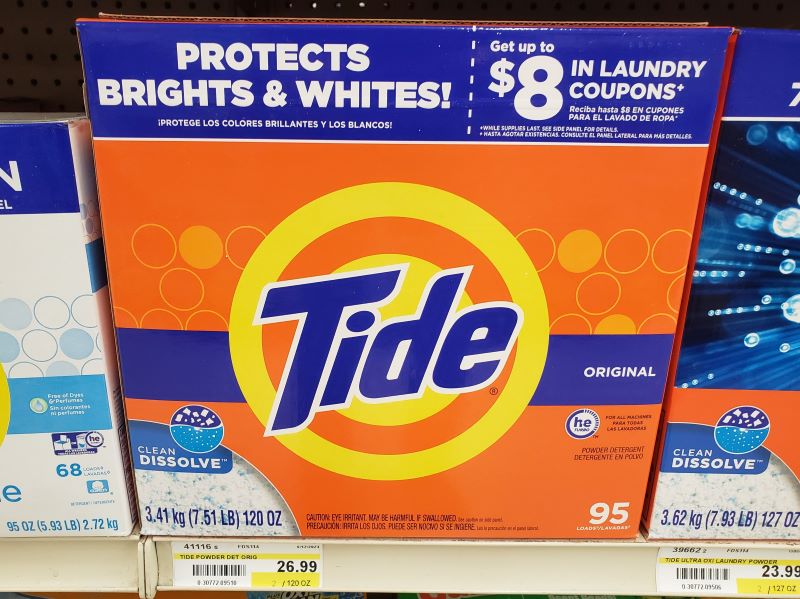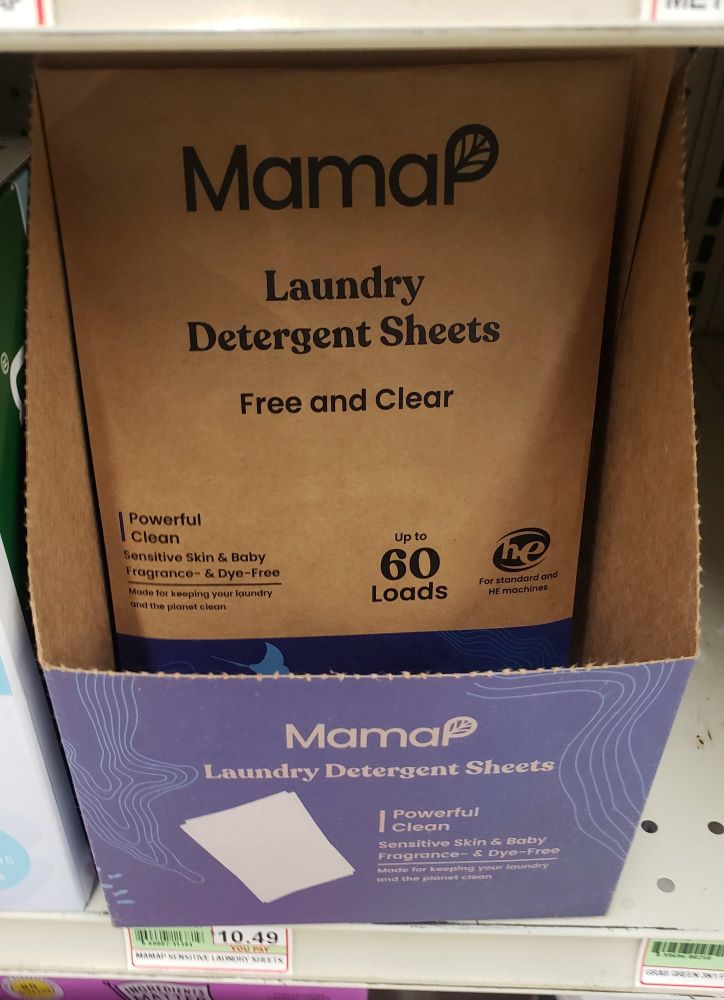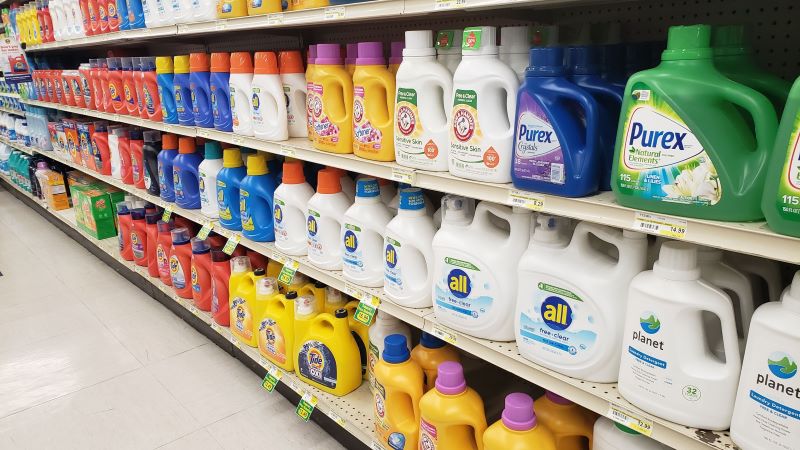Laundry detergent came in boxes for many, many years. Not the boxes lined with plastic. Just simple carboard. Throughout my life the detergent in them has been dry powdered. I’ve always recycled the boxes because they’re clean when empty.
Plus, they’re biodegradable.
But over the years since around 2010 store shelves have changed over to liquid detergent in big, thick plastic jugs.
These are not biodegradable.

At all.
And even though they come with the plastic recycling symbol only 29% of plastic PET and HDPE bottles like these get recycled at this point.
Plus their insides are heavily contaminated with detergent residue, requiring conscientious washing, in some places.
If and where there is a recycling program to handle these jugs, some would be recycled into recycled polyester fibers for clothing manufacturers, turning that plastic into fibers that break and shed into the greater environment, harming aquatic animals.
What caused this change from eco-friendly packaging to very eco-unfriendly detergent packaging?
I’ll describe why it’s happened and what the options are to eliminate the planet-damaging packaging and do our laundry in a much more eco-friendly way.
Because I know navigating a path to more eco-friendly living can be confusing and difficult. My hope is to give you the info you need to make decisions on what products to use and practices to switch over to, to reduce your impact and improve our beautiful planet’s health for the long-term.

Recycling plastic jugs usually doesn’t happen
First of all, plastic recycling is still in its infancy. Paper, glass, and can recycling started in the late 1960s and ‘70s when the environmental movement got started. That was when a disposable culture grew, litter was found everywhere, and landfills expanded. Curbside recycling started way later in the late 1990s.
Recently we’ve added plastic recycling to our curbside recycling with many plastic containers boasting the recycling symbol at the bottom,
It took a while to get recycling going. But plastic is a newcomer and the infrastructure hasn’t caught up with the scale of plastic production.
Of all plastic that ends up in the municipal waste stream only 8.7% gets recycled, filling landfills instead. More of it gets burned for energy production which “emits 3.8 times more greenhouse gases than the average energy grid…and is significantly dirtier than coal and oil”.
By 2018 29.1% of plastic bottles and jars made of PET (polyethylene terephthalate) was recycled into new products, and 29.3% of HDPE (high density polyethylene) was recycled, as reported by the EPA.
So, that’s… getting there… ? But some polyester bottles get recycled into polyester fibers that shed plastic microfibers all over the earth. Which damages all aquatic life and more.
Meanwhile, the oil industry is pushing to make more plastic.
The oil industry needs to make plastic… oil demand is down
More renewable energy is being generated and more energy efficient vehicles and appliances have reduced the demand for fossil fuels (yay!…but we’re not out of the woods yet). This has prompted the fossil fuel producers to look to petrochemicals (chemicals derived from coal and oil) to keep the demand up for them.
The source for plastic is petrochemicals and they’re now looking at plastics as a growth market. And with federal subsidies to the fossil fuel industry (your tax dollars at work) making plastic is the fossil fuel industry’s cheapest option for a growth industry.
The problem is that most plastic ends up languishing in landfills, or as litter on the land or sea. Only 9% of all plastic ever made has been recycled, because generally, making virgin plastic is the cheapest option.
Katie Brigham, author of How the fossil fuel industry is pushing plastics on the world, CNBC
So, that’s why more and more packaging is in plastic. I’m sure you’ve noticed those shelves in the laundry and cleaning section of the grocery store. They’re lined with plastic jugs and bottles from top to bottom.
It used to be cardboard boxes and even paper cans with metal lids, like for Comet and Ajax (which still is) and long ago, glass bottles. But now it’s overwhelmingly plastic.
One company’s marketing ploy is probably the one that started this change.
A marketing ploy that hooked us on plastic
In the early 1980s new liquid detergents and soaps were novel and they were promoted with very successful advertising campaigns. Then Colgate-Palmolive launched a new powdered detergent in a clear plastic bottle and called it Fresh Start. It stood out in the laundry shelves and its uniqueness garnered a large share of the market. (See the story here.)
But given this push by oil companies to produce more plastic, it’s no surprise that more and more plastic packaging is showing up everywhere.
So liquid detergents and liquid soaps have become the new normal.
One of the reasons often given for using liquid detergent has become that it dissolves better in cold or warm water. We’re encouraged to wash in cold or warm water to save energy in heating water.
But there’s a problem with that.
Why liquid detergent?
Liquid detergent is detergent with a lot of water in it. It’s much heavier than dry powdered detergent. So transporting it uses more fuel. And I dare say, each hot water wash might even use less energy than what’s used in transporting heavy liquid detergent.
Besides, most powdered detergents can be used in cold water, just read the labels to be sure. Or it can be dissolved in water before adding to the machine.
So is a heavy detergent in a big plastic jug, that may only occasionally get recycled, and that is never going to biodegrade worth it?
This goes for liquid hand soaps, too
A bar of soap usually has simple packaging. Until recently it was paper. Now it’s plastic wrap. But the huge amount of liquid hand soaps are in disposable plastic jugs. With disposable plastic pumps.
In 2021, 402.4 million units of liquid hand soap and 624.45 million units of liquid body wash (soap) were sold, whereas 295 million units of bar soap were sold. (Source)
That’s 1,027 million plastic containers of soap vs. 295 million packages of bar soap with minimal packaging sold in the US.
And, as in the detergent story, liquid soaps have a lot of water in them, making them heavier than bar soaps, taking more fossil fuels to transport them. And obviously a much bigger carbon/environmental footprint.
What are better options than plastic jugs?
Powdered laundry detergent is still available. But you have to look for it in the right places. You may not find them in big box stores or in the major supermarket chains. I get mine from my local independent grocery store (a local family-run store). They’re sold at food co-ops and other natural-food focused stores. One brand I use is Country Save.

But there is a new, very novel, and very low-waste laundry detergent. It’s a concentrated dry detergent that comes in sheets. There are many manufacturers of them and most come in small, biodegradable, fully recyclable paper packages.
Laundry sheets—lightweight and plastic-free laundry detergent
These sheets all work with any type of washer. Some are ultra-concentrated. And their compactness helps keep laundry rooms tidy.
For front loading machines you should tear the sheets into smaller pieces for the detergent tray to speed up the wetting and dissolving process.
Some loads will need from ½ a sheet to 2 sheets, depending on load size and how heavily soiled the laundry is. Follow manufacturers recommendations.
Here are some of the brands that make these:
(Price comparisons below are per sheet price. Many companies offer subscriptions with additional savings, too .)
Net Zero Strips: $0.49/load
Tru Earth Laundry Detergent Sheets: $0.53/load
Clean People Laundry Detergent Sheets: $0.41/load
Earth Breeze: $0.24/ load
Sheets Laundry Club (veteran owned): $0.32/medium load
Blue Water (they boast earning lower profits to keep their price very competitive): $0.14/load.
MamaP: $0.20/load (at my local grocer)
I think that this way of making and packaging laundry detergent makes waaaay more sense!
(As an Amazon Associate, I earn a small commission from qualifying purchases. This helps me spend the time to bring you well-researched information.)
So, when you use liquid laundry detergent:
- You’re burning more fossil fuels to get laundry detergent to you, impacting the climate
- You’re adding a huge volume of thick non-biodegradable plastic to the landfills (unless your jugs have been lucky to find their way to a recycling facility and are clean enough to get used)
- And you’re satisfying the fossil fuel giants’ to keep their bottom line up in a world that’s moving away from fossil fuels.
Switch to a much better, more eco-friendly way to do your laundry
Get your detergent in dry form—powdered in boxes, or even better, in dry laundry sheets, with minimal, recyclable, biodegradable packaging.
You can probably feel a little freer to use hot water, too.
Related Reading:
Microplastic: The Most Insidious Plastic Problem
Just Stop Wearing Plastic Clothes!
Is Cotton Bad for the Environment?
Natural Fibers vs. Synthetic Fibers, Which are Better and Why


Thank you for reading and enjoying these articles!